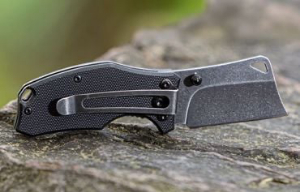
KNIFE SHARPENING ANGLE GUIDE
In this knife sharpening angle guide, we'll take a deep dive into the concept of the sharpening angle including its importance, how to determine the correct angle, and how to maintain that angle consistently. So, whether you're a professional chef looking to refine your kitchen knife or an outdoor enthusiast looking to restore your pocket knife, we've got you covered. After all, the value of a well-sharpened knife goes beyond usability – it’s the assurance of a more efficient and enjoyable experience.
Understanding Sharpening Angles and Why They Matter
When it comes to knives, one important principle remains consistent - all knives have an optimal sharpening angle that delivers the best performance. But what is a sharpening angle?
The Basics of Sharpening Angles
The sharpening angle refers to the angle between the knife's edge and the stone used to sharpen it, often described in terms of degrees. This angle significantly affects the cutting skill, durability, and overall performance of the knife. The science of it may sound complex, but understanding sharpening angles is pretty straightforward.
Angles for Different Types of Blades
Different blades require different angles, and knowing these differences directly impacts the effectiveness of the sharpening process. Let's take Japanese knives and Western knives, for instance. Japanese knives, known for their extremely sharp edges and delicate tasks, work best with a lower angle, typically around a 15-degree angle. On the other hand, Western-style knives, built for rugged tasks, work optimally with a wider angle (approximately a 20-degree angle). This also pertains to subcategories of knives. A knife with a single bevel (sharpened on one side) has a different sharpening angle compared to a knife with a double bevel (sharpened on both sides).
Angles for Different Knife Uses
It’s not only about the type of knife; the nature of the tasks the knife will perform also significantly influences the ideal angle. A pocket knife that may serve versatile functions from hunting, camping, or other outdoor purposes may require a slightly different angle compared to a chef’s knife which is designed for chopping a specific type of food.
Step-by-Step Guide to Determine the Correct Sharpening Angle
After understanding why various knife types warrant differing angles, let's now delve into how you can determine the correct sharpening angle for your knives. Here's an easy-to-follow process.
Step 1: Choose Your Knife
Select the knife you want to sharpen. It could be your trusty kitchen knife, pocket knife, or your straight razor. Each has a different proper sharpening angle.
Step 2: Identify the Correct Knife Sharpening Angle
Identifying the accurate angle is critical. Refer to the manufacturer's guide if you have it or you can use generalized guidelines as outlined in the graphic above.
Step 3: Use an Angle Guide
An angle guide can be incredibly beneficial for maintaining a consistent angle during sharpening, especially for beginners. It ensures you do not waver from the correct angle, delivering a uniformly sharpened edge. Many sharpeners have a fixed angle slot built in for total angle control!
Step 4: Develop Muscle Memory
This part largely depends on your steadiness and concentration. If you’re using a handheld sharpener without an angle guide, try maintaining the angle yourself. You may falter initially, but with practice, your hand will remember the movement and angle, making the process easier over time.
Step 5: Examine the Knife Edge
After you've run your knife blade over the sharpening stone at the correct angle a few times, it's essential to examine the edge. Using the proper light, look for uniformity, noting any inconsistencies along the edge that could affect the knife’s performance.
Remember, each knife type and sharpening method requires different frequencies on how often they should be sharpened. However, with regular use, every knife will need to be sharpened again. Monitoring your knife's sharpness and practicing consistency during the sharpening process will keep it in its best condition and ensure its longevity.
Choosing the Right Sharpening Tools
Now that you know and understand what the proper sharpening angle for your knife is, you need the correct tools to make the magic happen. The choice of sharpening tools makes a considerable difference to the quality, longevity, and precision of your blade's edge.
Pay Attention to Grit
When selecting the ideal knife sharpening tool, paying close attention to grit is crucial for achieving the desired sharpness and edge durability. Grit levels on sharpening stones play a pivotal role in determining the aggressiveness of the sharpening process. Starting with a low grit stone is essential for repairing or reshaping dull or damaged blades, as it removes material more quickly. As you progress, transitioning to a finer grit helps in refining and polishing the blade, culminating in a sharp, delicate edge. For knives that require a very sharp, straight edge, such as those used in precision cutting, opting for a higher grit diamond stone ensures that the cutting edge is both sharp and durable. Balancing between low grit for foundational work and finer grit for finishing touches is key to maintaining a sharp, effective, and resilient cutting edge.
Manual Knife Sharpeners
Manual sharpeners offer the advantage of control, allowing users to achieve precise and consistent angles. One of our more popular options is the Diamond-Arkansas Precision Sharpener, which offers unmatched versatility. For example, the diamond stone is known for its fast material removal, making it ideal for fixing a dull blade. But don't forget manual sharpeners can come in all shapes and sizes. Pull through sharpeners are a popular choice due to their simple nature and ceramic rods are popular for chef's knives. Make sure to take a look at all your options and determine which is the best fit for your application.
Electric Knife Sharpeners
On the other hand, electric sharpeners win when it comes to convenience and speed. They efficiently do most of the work for you while ensuring the precision of the sharpening angle. Time-constrained chefs or those finding difficulty maintaining the right angle may benefit immensely from these sharpeners.
Sharpening Tools for Honing Your Blade
Apart from these, there are unique sharpening tools like belt sanders, leather strops, and honing solutions which play their role in the finishing stages of the sharpening process. Belt sanders and leather strops are good for honing the edge of your knife and providing a finishing polish. These work great in tandem with a honing solution for those who settle for nothing less than the best edge.
Remember, choosing the right sharpener, just like defining the correct angle, largely depends on your knife type and personal preference. Using the right sharpening tool corresponding to your knife type enhances your blade's longevity, maintains sharpness for a longer period, and delivers optimal cutting performance.
Honing Your Edge: Knife Sharpening Angle Guide
In this guide, we've dived into the pivotal aspect of a knife's performance and longevity - the sharpening angle. We've uncovered that sharpening is a delicate process that needs an understanding of your knife type, its purpose, the sharpening angle, and the equipment used.
The principle is simple yet profound: different types of knives require varying angles to work optimally, from robust machetes to delicate Japanese blades. Recognizing these requirements and using an angle guide can go a long way in maintaining a consistent angle and providing a uniformly sharp edge.
How Smith's Can Help
However, recognizing the correct angle is only half the battle won. The other significant part of this equation is choosing the right knife sharpener. Whether it's a precision sharpener for delicate projects, a diamond stone removing material fast, or a natural Arkansas stone providing a polished finish, Smith's Consumer Products offers a wide range of sharpeners catering to your every need.
We trust that with this newfound knowledge and the consistent practice of these principles, you'll give your blades the long, useful life they deserve. While keeping your blades sharp might seem daunting, remember the adage – practice makes perfect. It won’t be long before you master the art of maintaining the perfect edge for your knives.
To experience the superior quality of sharpeners we offer, explore the wide range of sharpening tools from Smith's Consumer Products, and let's enjoy better, sharper knife use!




